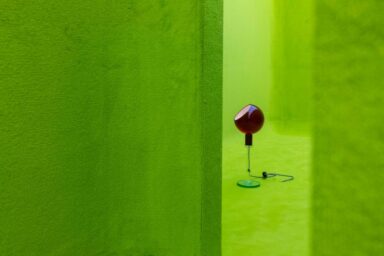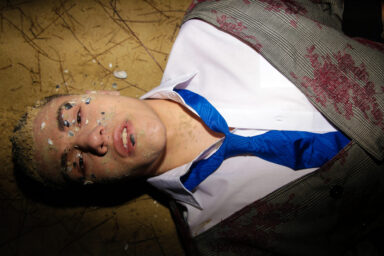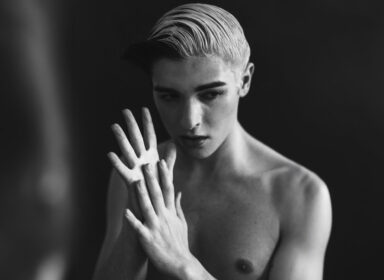Paris Men’s Fashion Week reminds us of a terrible truth: there is no single way forward
Text by Gianmarco Gronchi
You look at Paris and you are stunned. You are seized by a sense of profound ineffability. You can try to give a definition, but it will always be subject to the fallacies of logic and words, incapable of an all-encompassing vision of the multiform spectacle before us.
Look, for example, at Y/Project collection. In addition to his collaboration with Jean Paul Gautier, who retrieve archival trompe-l’oeil for the occasion, Glenn Martens chooses to follow several paths simultaneously. A risk that few are able to take, but which Martens resolves in a conflict entirely within the garments. Jumpers become a tangle of ropes, or fall apart in a sequence of overlapping planes, while sweatshirts and denim curl into a seductive multitude of drapes. As in a magic ritual, Martens is able to speak the secret language of eclecticism but holding all the threads together through a personal vision, which works according to the architectural rules of volume and texture. Padded jackets swell into cocoons from which beautiful butterflies are ready to emerge. Perhaps this is no coincidence.
Yohji Yamamoto, on the other hand, follows the path of seriality, but with no lack of inventiveness. Cerulean make-up and anarchic plastered bows for a series of looks that hark back to the Gothic 19th century. In a parade where the slightest variations make all the difference, black is chosen as the only colour for outfits that appear to be classic, but in reality are driven by an underground tremor. A convincing mix magically suspended between Jack the Ripper and the avant-garde conceptualism.
Homme Plissè Issey Miyake, with new creative director Satoshi Kondo, also thinks of clothing in structural terms. The collection, A Work of Arc, is all about the idea of clothing as sculpture, which can be transformed and rethought endlessly. Indeed, even the forms of human physicality are infinite. Once again, a convincing response from a brand that – maybe in the path of an oriental Zen spiritualism – avoids any kind of excess, dedicating its research into garments and their architecture.
On Avenue Montaigne, the direct confrontation between the Dior’s heritage and the need for a convincing response to today’s menswear is renewed. Against the backdrop of the Pont Alexandre III, reconstructed to scale, a very sober fashion show was staged, reflecting a collection inspired by the colour palette of winter Paris. A normcore collection, where Kim Jones’s streetstyle mark is thinned in relaxed sartorial fits, avoiding the much-abused collaborations just right for a few more likes on social media. In spite of this, the collection – to use a pictorial terminology – seems more like an impression of something in the making, perhaps due to the fact that Jones has begun to explore territories he does not know perfectly yet. Paul Smith, on the other hand, knows those paths perfectly, as confirmed by his new men’s collection, played on polychrome geometries and tailored cuts, suitable for every aspect of life. Rick Owens created an exaggerated show in which maxi shapes and super-emphasised shoulders fit into cut-out dresses that flake and reform in an electrifying atmosphere. The provocation is translated into a fetish-dark ensemble, but with sensual accents.
Sensuality is declared from the first frame of Dries Van Noten digital presentation, where clothes are accompanied by explicit effusions of love. A decadent and never vulgar sentimentality, which feeds on classic garments rethought with slippery fits and shining silks. A decidedly creepy aesthetic from Undercover catwalk, where Jun Takahashi uses Alfred Hitchcock as a visual reference point for a collection in which, once again, the identity of the male body is seen as something constantly mutating. As a result, prints and patches on black jackets and electric colours for knitwear, with pleated skirts to complete the look. If horror cinema marks the aesthetic, peace reigns in Takahashi’s head.
This continuous rewriting of contemporary dress codes is translated by Sacai into a collection that see nomadism as its conceptual and aesthetic basis. Patchwork and layering games are proposed for both men and women, while on a brown-and-grey based palette there are flashes of colour that look to the gypsy world. A collection that looks back nostalgically to the pre-pandemic times, when it was still possible to move freely, but that also seeks to look optimistically to the future, when we will regain that freedom that is currently denied.
Christophe Lemaire and Sarah-Linh Tran also started with the idea of travel, but in a completely different direction. In fact, Lemaire’s new collection is made up of free forms, expertly cut, that envelop bodies without suffocating them. A sophisticated functionality with tobacco trench coats and asymmetrical outerwear, where unisex looks testify the desire to participate in a shared way in the new global village.
Lucie and Luke Meier, for the new Jil Sanders collection, use crochet to finish every detail of classic garments in which it is the attention to detail that makes the difference. Stitched hats and crochet embroidery as the differential that turns a set of suits and dinner jackets from the most rigorous formal to a more relaxed worldly hippy vibe. A work that shows how artisanal know-how still worth, with the soundtrack by Panda Bear and Animal Collective on the background. Hed Mayner’s classicism enchants for the coherence of the vision. For the next winter season, the key word is just one: oversize. From suits to trenches, from knitwear to trousers, forms are maxi emphasized, in a collection that aims to dematerialize the male body in an overlapping of autumnal colours layers. An intriguing proposal that hides the human body instead of showing it, but that alludes to a sensuality to be rediscovered. Jonathan Anderson’s work for Loewe is not just provocation. The British designer shows clothes that badly deform the body, deconstructing it as if it were a set of crumbling planes, in an ensemble where rigid appendages interpenetrate with dreamy wool and crochet. There is no lack of disturbing prints, taken directly from the world of memes and the Internet. Loewe’s winter 2022-2023 will be populated by figures that appear to be happily catchy but intimately corroded by a cringeworthy conceptualism instead.
Turn the page and the Parisian fashion scene changes again. Walter Van Beirendonck projects us into a visual universe where anthropomorphic figures meet alien humanoids, all unified by masks and balaclavas. The result is vaguely disturbing, like a sci-fi thriller, with coats and jackets with emphasised sleeves and circular shoulders. The subtle sense of disquiet of energetic silhouettes with aggressive physiognomies is tempered by electric hues and geometric prints, vaguely reminiscent of Italian avant-garde design from the 1980s, from Alchimia to Memphis.
The collection designed by Veronique Nichanian lacks any sharp edges, preferring to work on the subtle redefinition of the codes dear to all Hermès lovers. Asymmetrical high necks and tapered lines in a collection whose details seem to wink at a youthful clientele. And does it really need sharpness to be successful? Hermès’ pieces probably won’t make it onto your Instagram feed, and that’s okay. In fact, the spasmodic race to retweet and to share too often leads to forgetting the object of the work. And so, it all comes down to a room of extreme fun, where the important thing is entertaining, perhaps with the disco notes of Jamiroquai as a light-hearted accompaniment, one photo after another, one video after another.
The same dimension of carefree entertainment reigns at Louis Vuitton, where the last collection designed by Virgil Abloh before his death is on stage. Vuitton’s collection is neither lyrical nor dramatic. Rather, it is the last, extreme essay of one of the greatest creatives of our generation. The collection looks like the work of a designer who feels that time is no longer on his side and is seized with the anxiety of not having said enough. The men’s collection for the coming winter season is therefore a jumble of all the stylistic elements dear to Abloh: electrically coloured varsity jackets, sparkling colours, interpenetrating square shapes, hyper-accessorized and multi-tasking looks with a streetstyle mark. The stage, which has the shape of a house, symbolises the joyful and creative labyrinth that reigned in Abloh’s head, in a tightrope walk between different disciplines. Closing the show, the sugary arrival of the angels puts an end to the energetic vitalism that animated the catwalk, but also to Abloh’s own career. A full stop, waiting to see the choices of a brand that will now have to find someone to pick up the heavy inheritance. Not an easy choice, but the show must go on.


